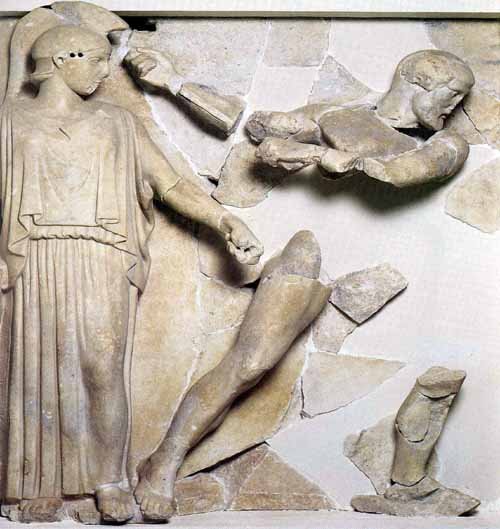Fifth Labour (Stables of Augeias)
Angry at Heracles for running off seeking new adventure with the Argonauts, Eurystheus decided that the fifth labour would be the most humiliating of his tasks: cleaning the Augeian stables in a single day.
Augeias was the king of Elis, and he owned the largest herd of cattle. Heracles wanted a tenth of the cattle as payment for cleaning the stables. Augeia readily agreed, not believing that it was possible to do so in a single day.

Heracles cleaning Augeias' Stables (Athena on the left)
Metope from Zeus temple, 460 BC
Archaeological Museum, Olympia
The task was enormous, because of the number of stalls of the stable, as well as the sheer size of the building. Heracles completed this task by diverting the water on the rivers Alpheius and Peneius to flow through the stables.
However, Augeias refused to honour his bargain, because the king had found out that the hero was performing one of the labours for Eurystheus. Only Phyleus, Augeias' eldest son, supported Heracles, asking his father to not break his promise to the hero. Augeias angrily banished his son from Elis. Phyleus left the city of Elis and settled in Dulichium.
Angry at being cheated of his payment that was promised to him, Heracles vowed to make war upon Elis when he was released from his services with Eurystheus. Augeias, realising that he had made a powerful enemy, allied himself with the general Amarynceus and the Moliones, Augeias' nephews. See the Wars in the Peloponnesus.
Again, Eurystheus refused to count this as a labour. Eurystheus told Heracles that he must do any labour without payment. Therefore, Heracles had to do another extra task.
Dexamenus, king of Olenus (in Arcadia or Achaea?), entertained Heracles as his guest. While he was at court in Olenus, the Centaur Eurytion tried to force Mnesimache, daughter of Dexamenus, to marry him. Heracles repaid his host by killing Eurytion.
Related Information
Sources
Library was written by Apollodorus.
Description of Greece was written by Pausanias.
Argonautica was written by Apollonius of Rhodes.
Related Articles
By Jimmy Joe






